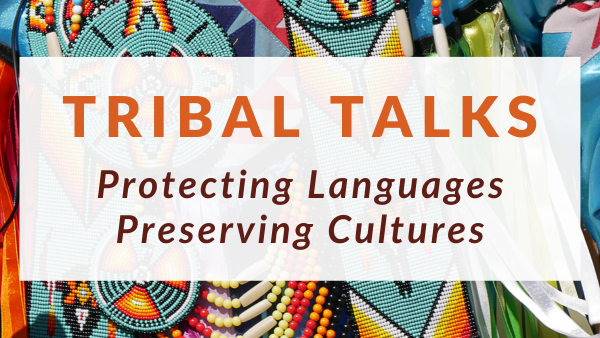Home / News / 2023-2024 News / A discussion on the importance of teaching and protecting Native languages on Wind River
A discussion on the importance of teaching and protecting Native languages on Wind River
Home / News / 2023-2024 News / A discussion on the importance of teaching and protecting Native languages on Wind River
A discussion on the importance of teaching and protecting Native languages on Wind River

What are some of the challenges when it comes to preserving the Shoshone and Arapaho languages on the Wind River Reservation? And what’s being done to pass those languages down from generation to generation? Those questions are at the heart of an upcoming talk in Jackson on March 18th titled “Protecting Languages, Preserving Cultures.”
In the Eastern Shoshone tribe, less than a hundred people are alive who can speak Shoshone fluently. That’s according to educator and language preservationist Lynette St. Clair, an enrolled member of the Eastern Shoshone tribe who will speak on a panel at the event.
She said the aging population of fluent speakers is one of the biggest threats to preservation efforts, which is compounded by limited opportunities to hear or speak the language conversationally or in a communal space.
“It’s very hard to find a place where you can find people to be able to converse with or hear it in action, especially coming out of COVID. Being able to observe Shoshone language being spoken between two people, three people, a group of people, it’s very limited,” she said.
For generations, Indigenous speakers were discouraged from speaking their native languages through assimilation efforts like Indian boarding schools. In 1978, the Native American Religious Freedom Act was passed and created protections for traditional aspects of Indigenous culture, including traditional language, but the road to revitalizing those languages has been an uphill battle.

St. Clair said the ways in which young people use social media and idolize social media influencers also creates a challenge for getting more youth involved in language education efforts.
“That leads to a lack of interest and kids just wanting to get rich and famous instantly, without putting the work in,” she said.
In her years working as a teacher on the Wind River Reservation, St. Clair would often have students ask why they needed to learn Native languages. She said she emphasized the ways in which language can help young people find their path forward into the future.
“I’d say, ‘There’s so many things you can do right now with the language once you learn it. You can be a translator, you can help people learn the language, you could teach your kids or your brothers and sisters. You could even think outside the box and create your own TV series or games,’” she said.
St. Clair has created culturally-informed lesson plans for organizations like the Wyoming Department of Education and PBS and provided translation consultation for the Amazon Prime television series “Outer Range.” She said one of her enduring goals as an educator is to add conversational context to vocabulary words like animals, colors and numbers, which have been taught in classrooms for years.
“I’ve always wanted to see our language flourish in a way that when students come into the classroom, from the moment they enter, they can code-switch and are able to both speak in English and in Shoshone,” she said.
When it comes to solutions, St. Clair helped develop an Eastern Shoshone language app called Newe Daygwap alongside other language preservationists, elders, tribal members, and Deb Smith, Superintendent of Fremont County School District #21 and the district’s Board of Trustees. She said she’s cautiously optimistic about the role of technology in preservation efforts, but also hopes there can be more conversations about how A.I. might compromise the integrity and sovereignty of Native languages.
“As a tribe, I think we have to start thinking of ways in which we’ll be able to protect our language from people coming in and using it in a way that it’s not meant to be used,” she said.
According to St. Clair, the Eastern Shoshone Tribal Cultural Center has also been working on transcribing old archives of tribal meetings and events. She said she’s also optimistic about the ways in which projects like the Wind River Tribal Bison Initiativecan help younger generations learn about their interconnectedness with their non-human and human relatives.
“The more our young people understand that connection, I think the better off our future will be and our community will be once our young people understand that responsibility they have,” she said.
St. Clair will be joined on the panel by Northern Arapaho tribal member Marlin Spoonhunter, the president of the Wind River Tribal College, and by Ray Youngchief, an Arapaho Language Teacher who works with 6th through 12th graders at Wyoming Indian Schools.
The evening will also include a screening of a clip from the Disney movie “Bambi” in Arapaho, which St. Clair said will be an opportunity to showcase creative efforts to maintain Native languages. The event is part of Central Wyoming College’s Tribal Talks series and will take place at the Center for the Arts in Jackson on March 18th.
2660 Peck Avenue
Riverton, WY 82501
(307) 855 – 2000
Campus Map
120 Enterprise Blvd.
Lander, WY 82520
(307) 332 – 3394
Campus Map
240 S. Glenwood St #124
P.O. Box 4795
Jackson, WY 83001
(307) 733 – 7425
Campus Map
302 W. Ramshorn
P.O. Box 175
Dubois, WY 82513
(307) 455 – 2625
Campus Map
© 2024 Central Wyoming College – All Rights Reserved